
Grand Prix motorcycle racing is the highest class of motorcycle road racing events held on road circuits sanctioned by the Fédération Internationale de Motocyclisme (FIM). Independent motorcycle racing events have been held since the start of the twentieth century and large national events were often given the title Grand Prix. The foundation of the Fédération Internationale de Motocyclisme as the international governing body for motorcycle sport in 1949 provided the opportunity to coordinate rules and regulations in order that selected events could count towards official World Championships. It is the oldest established motorsport world championship.

Moto Guzzi is an Italian motorcycle manufacturer and the oldest European manufacturer in continuous motorcycle production.

Gilera is an Italian motorcycle manufacturer founded in Arcore in 1909 by Giuseppe Gilera (1887–1971). In 1969, the company was purchased by Piaggio.

A motorcycle engine is an engine that powers a motorcycle. Motorcycle engines are typically two-stroke or four-stroke internal combustion engines, but other engine types, such as Wankels and electric motors, have been used.

Robert MacGregor McIntyre was a Scottish motorcycle racer. The first rider to achieve an average speed of 100 mph (160 km/h) for one lap of the Snaefell Mountain Course in 1957, McIntyre is also remembered for his five motorcycle Grand Prix wins which included three wins at the Isle of Man TT races, and four victories in the North West 200. He died nine days after injuries sustained racing at Oulton Park, Cheshire, England in August 1962.

Fergus Kenrick Anderson was a British professional motorcycle racer. He was a two-time Grand Prix World Champion. His name appears on the Nazis' "most wanted" list drawn up prior to their intended invasion of Britain.
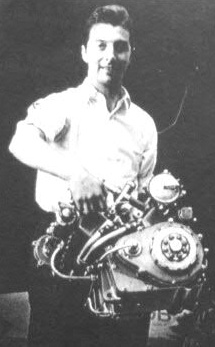
Bill Lomas was an English Grand Prix motorcycle road racer. He was a two-time World Champion and a two-time Isle of Man TT winner. He won the 1955 and 1956 350cc world championship as a member of the Moto Guzzi factory racing team. In the 1956 season, he rode the famous V8 Moto Guzzi Grand Prix race bike. Lomas was also an accomplished trials rider.
Richard H. Dale, known as Dickie Dale, was a Grand Prix motorcycle road racer born in Wyberton near Boston, Lincolnshire, England. In 1945, he was drafted into the RAF and served as a flight mechanic, and bought his first motorcycle, a 1939 AJS Silver Streak, while stationed at RAF Cranwell.
Duilio Agostini was an Italian Grand Prix motorcycle road racer. He had his best year in 1955 when he won the 350cc French Grand Prix and finished the season in seventh place in the 350cc world championship. He is not related to Grand Prix motorcycle racing legend Giacomo Agostini.
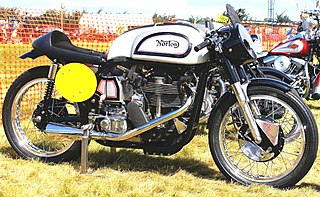
The Norton Manx or Manx Norton is a British racing motorcycle that was made from 1947 to 1962 by Norton Motors Ltd. Norton had contested every Isle of Man TT race from the inaugural 1907 event through into the 1970s, a feat unrivalled by any other manufacturer, and the development and honing of the Manx racing motorcycle was another step in this racing achievement.
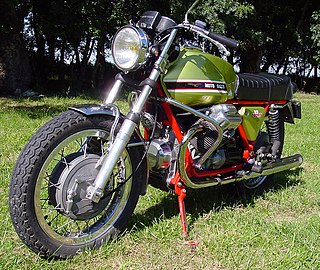
Lino Tonti was an Italian motorcycle engineer known for designing a number of sport and racing motorcycles in the 1950s and 1960s, and for creating his signature 'Tonti frame' for Moto Guzzi's 1971 V7 Sport, setting his stamp on all Moto Guzzis since.
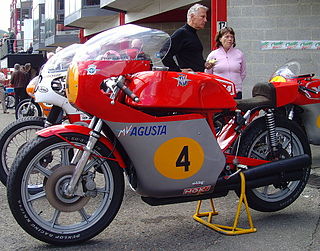
The MV Agusta 500cc road racers were motorcycles that the manufacturer MV Agusta built and which were used to compete in 500cc Grand Prix motorcycle racing series between 1950 and 1976. 18 500cc world championship titles were achieved with these machines ridden by John Surtees, Gary Hocking, Mike Hailwood, Giacomo Agostini and Phil Read between 1958 and 1974.

The MV Agusta 500 6 cilindri was a prototype racing motorcycle built by the Varese company MV Agusta in 1957. Only one prototype was made.

The MV Agusta 350 6 cilindri was a prototype racing motorcycle built by the Varese company MV Agusta in 1957, for the 350 cc class of the FIM Motorcycle World Championship. The project was resurrected in 1968. Neither version was ever used in a race. The only surviving model is now in the MV Agusta factory museum.
The MV Agusta 250 Monocilindrica Bialbero was a 250 cc factory racer manufactured by the Italian brand MV Agusta from 1956 to 1959. With this machine 15 GPs, 2 Driver Championships and 2 manufacturers World Championships were won.
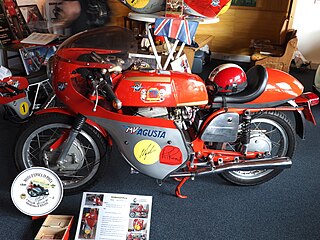
The MV Agusta 250 Bicilindrica was a 250 cc factory racing motorcycle manufactured by the Italian brand MV Agusta from 1957 to 1961. With this machine 11 GPs, 2 Driver Championships and 2 manufacturers World Championships were won.
The MV Agusta 203 Bialbero and MV Agusta 220 Bialbero were Italian factory racing motorcycles made by MV Agusta to compete in the 1955 250 cc World Motorcycle Racing Championship. The machine won three GPs and with it MV Agusta won that year's 250 cc Constructors Championship.
Piero Remor was an Italian engineer and motorcycle constructor, best known for his work for the Gilera and MV Agusta brands.













